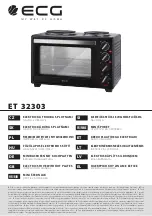
Greenfield Installation and Operations Stove
Page 34
NOTE: Installers must determine a neutral location of where to mount the thermostat
for accurate room temperature measurements.
Thermostat Control & Pilot Settings
The Stove may be controlled with a thermostat to help maintain a more constant temperature.
The Stove will react a little slower to a thermostat compared to a Gas or Electric Stove. With this
in mind the low setting can be adjusted to increase or decrease the amount of fuel used. This will
allow the heat output during the pilot stage to be matched to the size of the home. A larger home
will require more heat than a small one. Keep in mind that the Stove is constantly producing
some heat that helps heat the home while it is in pilot mode. If the home seems too warm, and
the Thermostat is never calling for heat, a lower pilot setting may be a better fit for the home.
(Read point 2 on page 27 for adjusting the feed rates on the low setting).
Remember: Choosing a lower Pilot setting may require the Draft Fan Voltage or the
Damper to be fine-tuned to match the lower feed rate. Monitor how the Stove is
operating after a change is made and adjust the damper or Combustion Fan voltage
accordingly.
Diagnostic Features of the Control Board
The #2 LED, #3 LED and #4 LED lights on the LED Light bar will flash to give a diagnostic
code to help in diagnosing problems that may occur.
(Read Frequently Asked Questions for more
information)
These conditions fall into 2 categories:
a.
Heat related issues.
b.
Vacuum related issues.
The Diagnostic Lights flash as follows:
1.
The
Proof of Fire
switch. This switch will sense the temperature of the Exhaust rising
during start up. If the Exhaust temperature does not reach 110 degrees F, or if, during use,
the temperature drops below 110 degrees F, the Stove will go into
“Internal Alarm”
and
the Auger will quit feeding fuel. Once the Stove completes the safety shutdown, the #3
LED will start blinking.
(Read Frequently Asked Questions for more information))
2.
The
High Limit
switch. This sensor will sense if the unit reaches temperatures that are
too high for normal operation. If this happens the Auger will quit feeding and the #4 LED
light will start blinking.
(Read Frequently Asked Questions for more information)
3.
The
Vacuum
switch. For the Stove to operate correctly the firebox needs to be sealed.
During the first 30 seconds after the unit has been turned on, the control board will check
to see if the switch senses negative pressure (Vacuum) in the firebox of the Stove. If there
is no negative pressure, the Stove will go into “Safety shutdown” and the #2 LED will
start blinking.
(Read Frequently Asked Questions for more information)
















































